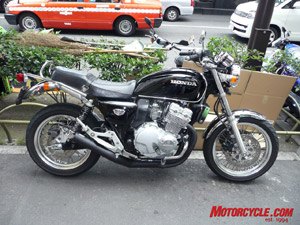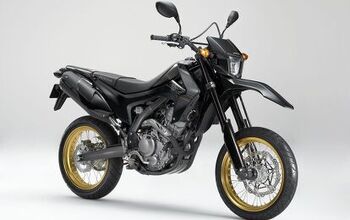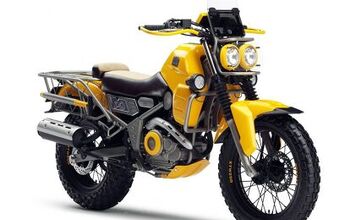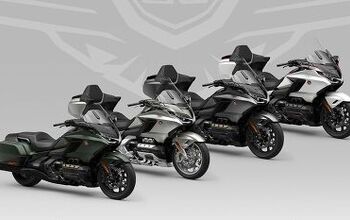Motorcycling in Tokyo
Spend a week in crazy Tokyo and I am not so sure you'll understand what goes on in the minds of our urban Japanese fellows. Considering the fact that this country stands behind many of our two wheeled fantasies, this might come as a bit of a shock.
From our western-world perspective, it's easy to imagine that Japan's motorcycling scene will be a showcase of rolling-on-two cutting edge technology. Well, people here might use the most advanced mobile services, have microchip controlled toilet seat heaters (a real treat, really!) and hop on ultra high-speed trains on a daily basis, but their rides are a different story altogether. Need a quick identity-kit for the average rider in Tokyo? Deep into nostalgic/retro stuff; a low-tech lover; doesn't really ever gas it; and maybe worst of all, often has a very dubious taste.
The strange hints start arriving as soon as I hop on the bus that takes me from the Narita Airport to downtown. I was half expecting to see hordes of two-wheelers in every stop light, but by the looks of it but the picture is far removed from Italy's mad city GP starting grids.
The second truth hits after a few days of strolling through town: An exaggerated majority of Naked Retros, while at the other end of the scale, customized scooters, ranging in freakiness from mild to wild, abound. The "in" thing to have in one of the world's style capitals is a 250-400cc scooter that's loaded with stuff from Japan's equivalent to Custom Chrome's catalog. Ornate chromed stick-on accents, tubular handlebars on billet risers, underslung neon lights that create funky effects during night rides. As if this wasn't bad enough, many of these crazy creations border on the really tasteless.
Tokyo's other half of the riding population chooses proper bikes... err, sort of. Just don't ask me where all those CBRs, GSX-Rs and ZXs are. The most popular bike around seems to be something called the CB400 Four, known here also as "Super Four." These guys have a predilection for understatement, don't they? A real retro tool that's not even sold outside of Japan with classic styling, spoke wheels and a frantic little water-cooled power unit that has fake fins for that true ’70s look.
For those who feel that the CB400 is just "too super," there's an even more frantic yet smaller 250 cc version. Yep, with four cylinders, too, even if that one is slightly more modern looking, a bit of a scaled down version of the Honda 599. The short stroke motor has the head sitting so close to the crankcases due to the tiny stroke that you'll need a magnifying glass to spot the cylinder block.
'The definition of cool 'round here seems to be ownership of a suitable modified Yamaha SR400.'
If there's a fun aspect to Tokyo's two wheelers, then it's in the proliferation of many models simply unknown outside of Japan, meant mostly for the domestic market. Such is the VTR250, looking like a miniature replica of a S4R Ducati Monster with its water-cooled 250 V-Twin engine and cool trellis frame. Or the tasty GSX-R400.
The definition of cool 'round here seems to be ownership of a suitable modified Yamaha SR400. A real British Single look-alike, the model is basically a destroked version of the late ’70s SR500 that sold for a short while in the U.S. A big part of those SRs undergoes serious customizations, from aluminum tanks and clip-ons equipped ’60s-style cafe racers to dirt track racer look-alikes with motocross bars and high-rise silencers. Really nice bikes that, unlike many of the other fake retros, can boast at least some credibility.
The only breath of fresh air comes from the increasing presence of aggressive looking street-legal supermotos. These are based on 250-400cc current enduros such as the KLX and DR, and the most popular and good looking by far is the 250 Kawi. I would gladly put one aside for my daily jaunts into town.
So then, isn't there life beyond 400cc? Think more about multiples, like 1200cc and beyond. Whoever has enough dosh to allow himself something big goes all the way to top-of-the line stuff, though it must be retro styled of course. Think more about ZRX1200s, preferably in an Eddie Lawson Replica painting scheme, or Honda's little-known CB1300, and your there.
In order to get another angle on Tokyo's biking life, I dedicate one morning to the city's "Motorcycle district" near to the Ueno train station. The area is not that big, and in typical crowded Japanese fashion, a few dozen bike shops are crammed into half a mile. The shop facades might be narrow, but most have four or fives levels and the sight is impressive at first.
As I start to delve deeper though, it turns out that the dizzying variety of accessories is meant for domestic models only and that the riding gear is, to put it mildly, quite funky. Pink "Hello Kitty" leather jackets anyone?
A good place to hunt for late-model Shoei and Arai helmets is Corin. The place is crammed with lids and there are plenty of good deals. The big billboard size sign covering the entire facade of Corin's five levels shop is hard to miss. A huge photograph of a tough Japanese biker hero, leather chaps and jacket, open-face helmet with aviator goggles, straddling a meek Yamaha 250 dirt-tracker Single. Guess you get the idea by now.
The place does offer plenty if you are looking for parts to pimp up your Honda Helix scooter into a loud head turner. Considering the orderly nature of the Japanese and their introspective tea ceremonies, it's hard to understand why most scooters around seems to wear super loud exhaust systems, with some of the crazier aftermarket ones simply pointing up to the sky like flagpoles. The trend towards heavy scooter customization has lately pushed Yamaha into producing the Cadillac Eldorado-inspired Maxam, know in the U.S. as the Morphous, and rumor has it that Honda will follow the move soon.
'There is fun to be had on two wheels here...'
In a tiny ground-level shop that seems to be more into sporty stuff, I finally find a friendly mechanic who speaks a little English. I asked him why all the sport bikes here have such wide chicken stripes on their tires.
"Ale you clazy?" he responds. "Leaning a bike in Tokyo?"
Go tell him that even city roundabouts are a good place to clean your tires and stick your knee out a bit...
As we go on chatting, he reveals: "Yes, Japan motorcycles velly good, but government tough to motorcycle!"
And, indeed, getting an above 400cc bike here seems akin to mission impossible. Only last year was the ban on riding two-up outside city limits lifted. Yep, that's how it's like in the homeland of the Big Four.
'Considering the orderly nature of the Japanese and their introspective tea ceremonies, it's hard to understand why most scooters around seems to wear super loud exhaust systems.'
There is fun to be had on two wheels here, though. I spent quite a few evenings riding on the back of a friend's 500cc Yamaha T-Max scooter, and there's simply no better way to see this town. Riding through the mad Shibuya district, home to the world's biggest scramble pedestrian crossing (featured in "Lost in Translation") on two wheels is one hell of an eye opener. This city has 35 million habitants, mind you.
If you feel the itch while there, many shops will be happy to rent you one of those 400cc retro screamers. Just remember that like in England, they do drive on the left!
More by Yossef Schvetz

































Comments
Join the conversation